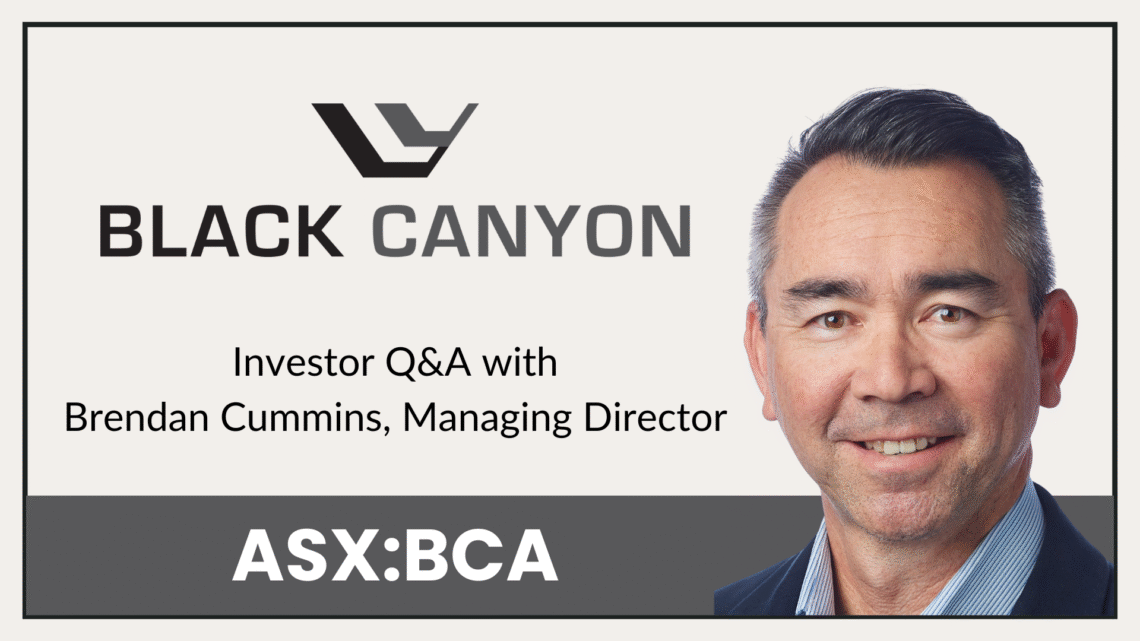
Black Canyon (ASC:BCA) confirms thick high-grade manganese and iron intersections at Wandanya
August 28, 2025Black Canyon Limited (ASX:BCA) has reported further assay results from the Phase 2 reverse circulation drilling program at its 100% owned Wandanya Project in Western Australia.
The results confirm thick, shallow and high-grade manganese and iron mineralisation extending across more than two kilometres of strike with widths of 160 to 450 metres, while the system remains open to the north and east.
With Phase 3 drilling underway and metallurgical studies planned, the company continues to expand its strong position in the Balfour Manganese Field and Oakover Basin. In this Q&A, Managing Director Brendan Cummins responds to key investor questions about the results and the Company’s forward strategy.
What do the latest manganese results tell us about the scale and quality of the Wandanya discovery?
The latest results highlight the scale and quality of the Wandanya system, with Phase 2 drilling producing some of the thickest and highest-grade manganese intersections encountered so far.
For example, hole WDRC125 intersected 7 metres at 40.1% manganese from surface, including 4 metres at 46.9% manganese from 3 metres depth, while hole WDRC126 delivered 6 metres at 37.9% manganese from 6 metres, including 3 metres at 46.3% manganese from 9 metres.
“The unique stratabound manganese mineralisation discovered by Black Canyon continues to impress, delivering consistent and widespread shallow manganese intersections.”
These results are consistent with intersections reported across more than two kilometres of strike, where mineralisation averages around 28% manganese over thicknesses typically between 4 and 5m and up to 12 metres.
Importantly, almost all of the holes contain higher-grade footwall zones grading between 35% and 45% manganese. The mineralisation remains open to the north and east, providing strong potential for further extensions as drilling continues.
How do the iron assay results fit into the overall project strategy?
Iron assay results from Wandanya provide an additional dimension to the project, complementing the manganese discovery with high-grade hematite.
Significant intersections include 13 metres at 59.3% iron from 1 metre in hole WDRC056, including 7 metres at 62% iron from 7 metres, and 12 metres at 59.3% iron from 4 metres in hole WDRC057, including 7 metres at 63.9% iron from 7 metres.
“We consider the iron results also announced today as a substantive bonus to the project.”
These shallow intersections extend along 800 metres of strike with mineralisation continuing 170 to 320 metres across strike and remaining open to the north and the hematite occurs up-dip of the manganese mineralisation.
While manganese remains the core focus due to its long-term strategic value, the iron mineralisation is important because of its high grades, shallow position and potential for direct shipping ore. Further drilling is required to determine the extent and continuity of this iron horizon.
What progress has been made with the current drilling program and what are the next steps?
The Phase 2 program has been completed with 101 reverse circulation holes drilled for 2,300 metres.
All assays have been received and validated through full QAQC processes, confirming the widespread nature of the manganese and iron mineralisation across two kilometres of mapped strike.
“Our mapping shows the manganese system is at least three kilometres long, which we have targeted as part of our Phase 3 drill program with visual confirmation of further manganese and iron mineralisation to the north.”
Phase 3 drilling, comprising 3,500 metres of RC drilling, is already underway and is designed to extend coverage across the full three kilometre strike of mapped mineralisation and completed some infill drill lines.
The program is on track to be completed by the end of August, with results expected from mid-October through November.
In parallel, a diamond drilling program is planned to collect manganese and iron core samples for metallurgical testwork during the wet season.
Can you provide more context on the metallurgical testwork results and their implications?
Metallurgical testwork on Wandanya mineralisation has confirmed that it can be upgraded into a high-value product.
“Metallurgical testwork has shown composite samples averaging 30% Mn can be beneficiated using density-based separation, which achieved a 45% Mn product grade exceeding the premium 44% Mn benchmark grade.”
For example, with an average composite feed grade of 30% Mn was able to upgrade using heavy liquid separation and produce a concentrate grading 44.8% manganese with a 79.5% average recovery.
These results demonstrate a clear pathway to producing a premium-grade manganese concentrate suitable for steel and battery markets.
The planned diamond drilling will provide fresh core material for further metallurgical studies, which will refine processing assumptions and support the next stages of project development.
How does Wandanya fit into Black Canyon’s broader strategy and landholding position?
Black Canyon holds 2,300 square kilometres of ground in the Balfour Manganese Field and Oakover Basin.
Across these projects, the Company has already defined the largest manganese contained resources in WA and second in Australia with a global mineral resource of 314 million tonnes at 10.4% manganese, including 100 million tonnes in the measured category, 150 million tonnes in the indicated category and 64 million tonnes in the inferred category.
Wandanya is a new discovery within this portfolio and represents a different style of high-grade stratabound mineralisation on the eastern margin of the Oakover Basin.
The discovery complements the existing resource base and has potential to add significant high-grade tonnes.
With manganese being non-substitutable in steelmaking and recognised as a critical mineral in lithium-ion batteries, Wandanya strengthens Black Canyon’s strategy of advancing projects that can deliver scale, quality and long-term value.
Building Momentum for Long-Term Growth
The Phase 2 drilling campaign at Wandanya has confirmed shallow, thick and high-grade manganese intersections while also outlining shallow iron horizons that add to the project’s optionality.
With Phase 3 drilling scheduled for completion by the end of August and assays expected from mid-October, Black Canyon is progressing both resource definition and metallurgical testwork that will underpin future development.
Wandanya stands as a cornerstone discovery within Black Canyon’s extensive landholding, aligning with the company’s strategy to advance critical manganese assets in Western Australia.
Please note the following valuable information before using this website.
Independent Research
Market Open Australia is intended to be used only for educational and informative purposes, and any information on this website should not be taken as investment advice or guidance. It is important to conduct your own research before making any investment decisions, which should be based on your own investment needs and personal circumstances. Any investment decisions based on information contained on this website should be taken in line with independent financial advice from a qualified professional or should be independently researched and verified.


